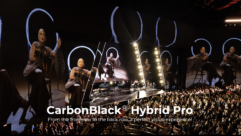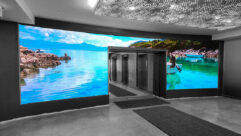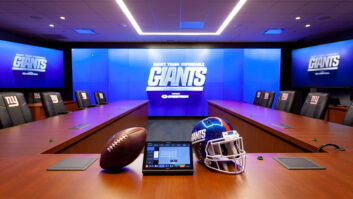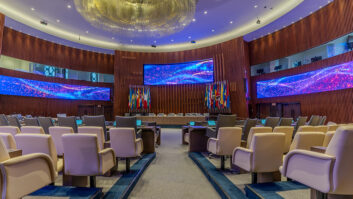
Technology Showcase: Large-venue Displays
Oct 1, 2007 12:00 PM,
By Jay Ankeney
Powerful video projection delivers a big message.

InFocus WorkBig IN42+
Showman P. T. Barnum was famed for saying, “If you’ve got something to say, say it big,” and advancing technology has given today’s AV pros a wide choice of options for taking that advice. Whether intended for use in an outdoor stadium, an indoor arena, or an enclosed amphitheater, large-venue displays are benefiting from the accelerating cascade of ever-higher-resolution imaging devices. Entertainment, signage, or messaging content not only can be shown larger than ever before, these days it can also be shown with visually discernable clarity.
Animated lights, mechanical flip boards, and even fireworks have been used in the past to entertain and inform large crowds. As computing systems became affordable, assemblies of computer monitors tiled together began to show up at multimedia events in the form of videowalls, which soon were found in both educational and entertainment installations. But the idea took a generational leap forward in 1985 when Sony’s JumboTron and Mitsubishi’s DiamondVision used a matrix of small CRT screens to create video displays for large venues. Since then, several videowall systems have increased in image size and density, although the mullions (the bar between screens) prevented them from rivaling true single-source video images.
Today, either LED (Light-emitting Diode) or LCD (Liquid Crystal Display) elements provide the light sources for most videowall displays. At the 15th Asian Games in Doha, Qatar, last December, Element Labs created what it touted as the largest custom LED screen ever used for a live event by using its Versa Ray LED technology to span the entire stadium with a curved screen 50ft. wide and up to 130ft. tall. It consisted of 762,000 individual LEDs with a pixel pitch of 3in. mounted onto large trusses woven with more than 36 miles of thin tubes containing the Versa Ray elements.
LCD technology is also maintaining its reputation for extra-bright videowall applications, with NEC bringing out its new 46in. MultiSync LCD4620 panel, which uses chevron-shaped CV12 pixel technology for the first time. With 1366×768 resolution, a 1200:1 contrast ratio, and a 10-millisecond response time, the NEC LCD4620 panels feature an ultra-thin bezel and the company’s Digital Signage Technology Suite (DSTS), enabling them to be combined into a 5’×5′ videowall that appears more seamless than has been possible previously.
VIDEO PROJECTION
However, for most people, a large-venue display is generally expected to be a video-projection system, although there is very little agreement on the required brightness of these systems. At this year’s InfoComm, the Large Venue Display Gallery used 7000 ANSI lumens as its threshold-brightness specification for front-screen projectors. However, one major manufacturer starts talking about large-venue displays only when the displays are capable of putting out 15,000 lumens or above. Pacific Media Associates (PMA), a market research firm tracking the video display industry, defines a large-venue display by weight — specifically, projectors weighing more than 33lbs.
However, to be as inclusive as possible, this article will include all projectors that produce more than 4000 lumens, because, in many cases, these projectors can generally be considered to be systems in which the size of the image is more important than its resolution. A growing number of large-venue projectors have migrated up from boardroom models as their LCD or DLP light engines have increased in brightness. But to suit them for outside-venue installations, these projectors need to have features such as interchangeable lenses, multiple mounting/rigging options, and the ability to correct for the skewed image plane, or keystone effect, that can be the result of the projector being placed some degrees off from a directly perpendicular angle to the screen.
The physical weight of projector design has come down so greatly over the past few years that many portable models can easily be used to throw images that can fill an auditorium, and their brightness is often doubled simply by bi-packing two (or more) projectors onto the same screen. So the dividing line between boardroom and large-venue projection models is becoming less defined than it was several years ago, when the video noise, operational sound levels, and brightness of fixed-installation projectors differentiated them more clearly.
One other point of confusion is the concept of measuring brightness itself. Conventionally, most projector manufacturers speak in terms of lumens, while LED or LCD displays are rated in nits. A lumen is the standard unit of luminous flux, which can be considered a measure of the perceived power of light. Luminous flux is adjusted to reflect the varying sensitivity of the human eye to different wavelengths of light, while radiant flux is the measure of the total power of light emitted.
A nit is a unit often used to measure the brightness of flatpanel or computer displays, and it represents one candela per square meter. Fortunately, because we will be dealing with large projection systems here, it is convenient to ignore the definition of a candela as “the luminous intensity of a source that emits monochromatic radiation of frequency 540Hz by 1012Hz and that has a radiant intensity in that direction of 1/683W per steradian.” So we will be referring to lumens rather than nits.
But, even when limited to discussing lumens, industry practice has tended to further confuse the issue. In order to provide a means of comparing the amount of visible light emitted by competing projectors, the American National Standards Institute (ANSI) has established a testing standard that is found by dividing the screen into nine areas and measuring the average of the luminance of each area. This is then reported as the ANSI-lumen rating of an individual projector.
However, many contend that a more accurate index of a projector’s performance should be “center lumens” — for which a spot photometer takes one measurement of the maximum level of white in the center of the screen. For example, a projector shining on a 100-square-foot screen could be said to produce 1500 center lumens but only 1175 ANSI lumens. But, because this method of rating projectors is not shared by the marketing departments of all manufacturers, ANSI lumens will be considered the basis of comparison here, with figures for center lumens provided when available.
To put these brightness concepts into context, a projector designed for a small room typically requires only 200 to 300 ANSI lumens, while a large-room projector may require from 400 to 600 ANSI lumens, and the illumination on a large-auditorium projector may be 2000 ANSI lumens. A digital-cinema projector is required to put out 5000 ANSI lumens. The biggest large-venue projectors are capable of 30,000 ANSI lumens each.
So the definition of a large-venue display these days is literally in the eye of the beholder. And that seems to be the way the market sees it, too. Using its definition of a projector weighing more than 33lbs., Pacific Media Associates pegs 2006 sales of large-venue displays at $120 million, with a forecast of $150 million in 2007. Expanding that to the more generous benchmark we’ll be using here of a projector capable of at least 4000 ANSI lumens, PMA sees sales of $485 million in 2006 for that level of brightness and going up to a predicted $684 million in 2007.
THE MARKET
Here is a look at literally the best and the brightest from major manufacturers of large-venue display projectors.
Barco claims its FLM HD18 is the quietest native-HD projector on the market, producing 16,000 ANSI lumens (18,000 center lumens) through fully sealed optics with a high-contrast mode of 2400:1. To save costs, the lens range (TLD HB) of the Barco RLM and SLM projector lines can be reused on the FLM series. At the brightest end, the Barco XLM HD30 projector is the company’s first 3-chip DLP projector with a native widescreen aspect ratio, native 2048×1080 resolution, and high light output of 30,000 center lumens. The XLM HD30 also features a fully sealed DMD engine that is protected against smoke and dust often found in entertainment and large event environments.
Canon‘s brightest LCD projector ever is the 5500-ANSI-lumen LV-7575. In addition to being HD-compatible in a native-XGA resolution, the LV-7575 comes with more image controls than ever before. It features a genuine Canon Optics 1.3X zoom lens that can throw an image up to 400in. across, enhanced by four optional high-quality interchangeable lenses including the Ultra Wide Angle, Wide Angle Zoom, Long Focus Zoom, and Ultra Long Focus Zoom. For flexible mounting, the LV-7575 has digital keystone correction, 2:3/2:2 pulldown for film and video detection, and network connectivity.
Christie Digital claims the most popular projector line and most installed worldwide in digital cinema theaters. For large-venue displays, the line begins with the LX120 LCD projector, which provides 12,000 ANSI lumens at XGA resolution. For the largest venues, Christie tops its extensive line with the Christie Roadie HD+30K DLP digital projector. Producing 30,000 ANSI lumens, the Christie Roadie HD+30K uses a unique, flexible split-body design and features a new scooped hood, improved rear air exhaust, and stackability, while the revamped lens mount increases its field-proven performance. With native 2048×1080 HD resolution and 10-bit image processing, images from the Christie Roadie HD+30K far surpass high definition in size, brilliance, and quality.

Digital Projection International Lightning 1080p
Digital Projection International (DPI), the original innovator of the 3-chip DLP projector, has brought out the Lightning 30-1080p and Lightning 40-1080p projectors, which include DPI RapidRig staging and stacking hardware with integrated pitch, roll, and yaw adjustments. Both use Texas Instruments’ native 1920×1080p chip to lower their cost over previous, 2K-capable Lightning projectors. The Lightning 30-1080p puts out 15,000 ANSI lumens, and the Lightning 40-1080p boasts 20,000-ANSI-lumen brightness in a widescreen format. Each projector offers a 2000:1 contrast ratio.
The LC-XT5 three-panel LCD projector that Eiki International just released in September presents 15,000 ANSI lumens at 90-percent uniformity and a 2000:1 contrast ratio, and it is capable of operation up to 23 hours per day with regular maintenance. The LC-XT5’s DVI input supports HDCP for true digital imaging up to 1080p, 2:3 pulldown support, and four input channels. For extended life, the LC-XT5 incorporates an inorganic LCD imaging engine, and its native-XGA resolution accepts video signal inputs including DVI, RGB, Y/C, DVD, and HDTV.
In June, InFocus introduced its Work Big IN42+ LCD digital projector and its new LiteShow II wireless adapter for a fully integrated large-venue wireless digital projection solution. Featuring native-XGA resolution, a 4:3 (native) or 16:9 aspect ratio, a 1000:1 contrast ratio, and 4000 max ANSI lumens, the InFocus Work Big IN42+ has an all-new web interface manager to enhance its control and productivity. InFocus also has its LP850 4500-ANSI-lumen LCD projector loaded with features such as power zoom, focus and lens shift, and an extended 1,500 hours of lamp life.
Mitsubishi Electric & Electronics USA was entered into the Guinness Book of World Records as having built the largest HD display in the world after it installed the 78’×74′ LED scoreboard in the Atlanta Braves stadium. The XL5980U/LU LCD multimedia model offers innovative color imaging with its Natural Color Matrix and sRGB color profile technology. With 5500 ANSI lumens and a 600:1 contrast ratio, the projector also provides motorized horizontal and vertical lens shift, offering extreme flexibility for most installations.

Sanyo PLC-XF47
Last April, NEC Visual Systems (plasmas and projectors) merged withNEC Display Systems (desktop LCD and large-screen LCD) to bring all the company’s products under one roof. In September, NEC announced the NP4001, its first widescreen, single-chip DLP projector delivering 4500 ANSI lumens at WXGA resolution. NEC’s Eco-mode technology increases lamp life by up to 50 percent, while its lamp-saver feature enables the cooling fan to continue running even after the power source in the NP4001 is disconnected.
The PT-D7700U-K is Panasonic‘s 7000-ANSI-lumen, SXGA+ large-venue 3-DLP projector, which offers a 4000:1 contrast ratio. Working together with the PT-D7700U-K’s liquid-cooled optical engine, Panasonic’s Dynamic Iris feature improves contrast by precisely matching the lamp output to the input signal. Rated as the world’s lightest 3-chip DLP projector at 4.5lbs., the PT-D7700U-K is designed with a sealed optical block and comes with a wireless/wired remote control unit. It even has a selectable nine-language onscreen menu.

Sharp XG-PH70X
The Sanyo PLC-XF47 LCD is the industry’s highest-light-output portable LCD projector, according to the company, with 15,000 ANSI lumens provided by four 330W lamps. The PLC-XF47 also features optional wireless transmission of 720p and 1080i HD content. In addition, Sanyo offers the PLC-XP100L, which it touts as the world’s brightest single-lamp LCD projector at 6500 lumens. The PLC-XF47 uses Sanyo’s exclusive Active Maintenance filter system, which automatically detects airflow and advances clean filter material as needed, resulting in less maintenance and increased reliability for around-the-clock operation. Both systems include Sanyo PJ-Net Organizer Plus C version 2.0 software. The software not only enables remote monitoring of projector functions, but it also includes a camera mounted on the projector, letting operators verify whether an image is actually hitting the screen even when they are off site.
Sharp‘s premier installation/integration projector, the XG-PH70X, offers 5200 ANSI lumens and a 1200:1 contrast ratio. The projector features a unique intelligent dual-lamp design that provides four brightness levels — 5200 ANSI lumens (standard mode — dual lamp), 4300 ANSI lumens (Eco mode — dual lamp), 2600 ANSI lumens (standard mode — single lamp), and 2150 ANSI lumens (Eco mode — single lamp) — for use in almost any venue. Just last June Sharp announced its latest-model XG-P610X, a 6000-lumen DLP .7in. XGA 3-chip Professional Projector that is expected to be released in Q1 2008. Combining extensive projector features from Sharp with Texas Instruments’ advanced 3-chip technology, the XG-P610X offers redundant operational reliability through the company’s dual-lamp optical system.

ViewSonic PJ1172
Now that Sony has brought out a new line of 4K digital-cinema projectors, the SRX-220 and SRX-210, presenting an awesome 4096×2160-pixel resolution from its Silicon X-tal Reflective Display (SXRD) imaging devices, their 24p/30p predecessors have been upgraded to the SRX-S105 and SRX-S110, with 60p-projection capabilities for large-venue display applications. The new models — rated at 5000 ANSI lumens and 10,000 ANSI lumens, respectively, and each with an 1800:1 contrast ratio — can take their inputs via DVI boards or other formats using the LKRI family of input cards. 4K display can be achieved using the included DVI input and three more LKRI 004 cards, and the display from the SRX-S105 and SRX-S110 can be divided into up to four separate 1920×1080 images.
The ViewSonic PJ1172 is a full-function multimedia LCD projector with native-XGA 1024×768 resolution at 4500 ANSI lumens. For video source flexibility, the ViewSonic PJ1172 lets you connect two computers simultaneously, add a video source for dynamic meetings, or even use another monitor output to view the same projected image on a separate display. Optional lenses — including the PJR-LEN-002 short-throw zoom lens, and the PJ1172, which supports HD signals including 720p and 1080i — make installation flexible.
Jay Ankeneyis an industry consultant and former TV network engineer living in the Los Angeles area.
For More Information
Barco
www.barco.com
Christie Digital
www.christiedigital.com
Digital Projection International
www.digitalprojection.com
Element Labs
www.elementlabs.com
Eiki International
www.eiki.com
InFocus
www.infocus.com
Mitsubishi Electric & Electronics USA
www.mitsubishi-hometheater.com
Panasonic
www.panasonic.com
Sanyo
www.sanyolcd.com
Sharp
www.sharpusa.com
ViewSonic
www.viewsonic.com










